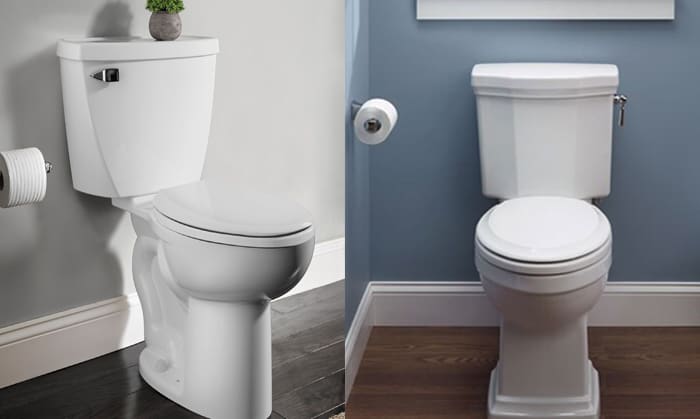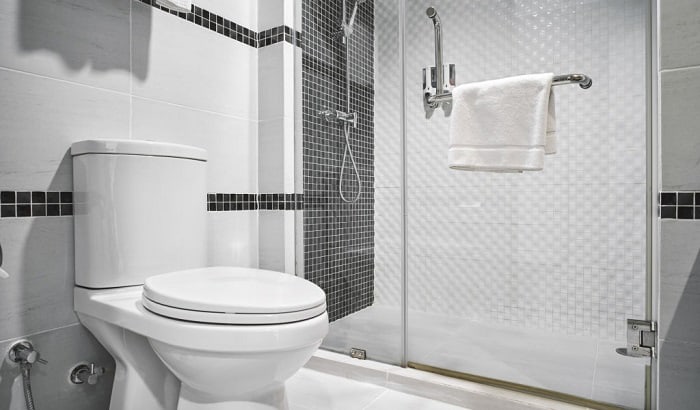Most buyers look at the flushing power or water efficiency of a toilet. Many are not patient to flush twice, thrice, or more. Regarding this matter, you need to look into 1.28 vs 1.6 GPF toilets that are currently sold in the United States.
Are you curious as to why there’s a difference in the digits? A 1.6 GPF toilet needs 1.6 gallons for every flush and a 1.28 GPF toilet should have 1.28 gallons. But the flushing capability of a toilet tank is not only based on water consumption. Other factors are integrated along with it. You’ll know them if you continue reading.
Table of Contents
GPF and Its Importance
GPF means the necessary gallon per flush to get rid of waste through the toilet. Older toilets have higher GPF than new ones, so they are wasteful and not friendly to the environment.
The implementation of the National Energy Policy Act began in 1992 to save water supply. To pursue this regulation, GPF should not be more than standard 1.6.
Recently, lower GPF is in demand like 1.28 GPF toilets and they can be found in most toilets and households. With the rising popularity of the 1.6 GPF toilets, every household can save around 20,000 gallons of water every year. 50% of water is saved because of the advancements of toilets with 1.28 GPF and bigger flush valves.
How Does GPF Affect the Toilet’s Performance
Judging the overall performance of a toilet bowl will be based on these factors:
- Loud flushing
- Possibility of clogging
- Flushing capability
These will depend on whether the toilet is operated by pressure or gravity. With toilets that operate by pressure, there are front jets for driving the water more quickly. But they’re noisier than the traditional or gravity-based type as they mix air with water to serve their purpose.
The type of toilet that works with gravity has advanced water velocity technology. It functions in siphoning solid waste through a downward slope. There are also dual-flush toilets that run through gravity as well. They have two flushing options, which are flushing liquid with a smaller amount of water and a standard flush.
The advanced technology applied in production leads to the creation of low-flow toilets. Hence, the misconception that these toilets are not as functional and powerful as those with high GPF was busted. Everyone can enjoy these ultra high efficiency toilets!
1.28 GPF toilets and 1.6 GPF toilets are tangible proof that impressed a lot of users. A low-flow toilet is recognized as a flush water-saving toilet. Furthermore, a single flush is necessary when you use them.
The required double flushing was prevented as it can only increase consumption and water bills. At first, these high-efficiency toilets caused clogs. But manufacturers were aware of this issue and resolved it.
Some manufacturers recognized the unhelpful effects of a flapper flush valve, which was replaced by the canister type. This change allows the water to flow at a 36-degree angle.
Toilet 1.28 Vs 1.6: A Comprehensive Buying Guide
Some buyers may only look at the appearance of a toilet or the toilet brands that they’re familiar with. For the sake of flushing power and efficiency, you have to decide whether a 1.6 GPF toilet or 1.28 GPF toilet suits you.
People who live in states that impose the usage of 1.28 GPF toilets have no choice but to follow the regulation. But if there’s no restriction in your area, there’s no harm in thinking over which would be the best toilet for you. Is it a 1.6 or 1.28 GPF toilet?
1.28 GPF Toilets
This version is effective and only needs 1.28 gallons for every flush. Since it ends the reign of high water consumption toilets, it’s deemed as environmentally friendly even to houses with several toilets.
In addition, a single flush can clear the waste efficiently. You would like it as it’s an affordable option that can help you conserve water. An example of this is Ultramax of Toto toilets and some one-piece toilets like Swiss Madison SM-1T803.
- PROS
- By using 1.28 GPF toilets, you’ll be able to conserve 3,000 to 4,000 gallons of water annually. You protect the environment and save money all at the same time. Some states give rebates when you buy one of them.
- CONS
- 1.28 GPF toilets only need small water usage when flushing. Thus, they’re low flush toilets that can be prone to stain and clogging after multiple flushing. They may not get rid of heavier waste and you’ll be obliged to double flush or even more. In some ways, you’ll end up not saving water at all.
- More Conservative Toilets
- Appearance and usage have nothing to do with the amount of water the toilet draws. It’s all about the internal parts and their functions. You’ll be surprised that you can find a difference in your water bill when you fail to get a water efficient toilet for your manner of usage.
- The water needed for a 1.6 GPF toilet is a third less than what’s necessary for a 1.28 GPF toilet. An average American flushes five times a day. This amount of water makes up for a quarter of daily water usage. Eventually, every toilet user can save two gallons daily.
- Nevertheless, you have to consider the size of your household. There may be five or more in your family. Hence, imagine the large amount of water that you can save.
- Are Toilets that Need Flushing Twice Deemed as Conservative Toilets
- There are always two different sides of things. 1.28 GPF toilets with low volume flush sometimes can’t discard a heavy waste or toilet paper in single flushing. Since there’s a limited amount of water when you flush, skid marks may show up.
- You’ll need 2.56 gallons of water on a 1.28 GPF toilet when flushing twice. This amount of water is more than what is taken out from a 1.6 GPF toilet. But this matter is acknowledged by toilet manufacturers so they designed a special power flush toilet to make the most out of the limited water volume.
- But these low-flow toilets are quiet. You may not value its importance but loud flushing can be annoying at night to those who are asleep. The sound can be scary for kids too.
1.6 GPF Toilets
This type of toilet requires more water than the previous but is still effective. It’s on par with the standards set by the Federal government but not all states accept this. You won’t be dismayed as it doesn’t have a weak flush.
Instead, heavy waste can be disposed of in one flushing. Moreover, it easily cleans up the stain and doesn’t usually clog. It’s the opposite of dual flush toilets as it gets its job done in one flush.
Watersense toilets make 1.6 GPF toilets like the Sheffield round front toilet and a two-piece toilet at the same time.
- Advantage
- Even though it uses a lot of water, it can work better than the 1.28 GPF toilets. Flushing can be done once without leaving any stain behind. There’s only a low chance of clogging. You can save water by not needing a double flush.
- Disadvantage
- 1.6 toilets owe a powerful flush from an extra amount of water. Due to the accumulated water usage, as time passes by, the effects are not good for the environment.
- The Importance of Volume
- The volume will show you the difference when flushing toilets. You’ll need to precisely look at the water volume and audible volume of flush. Since the 1.6 GPF toilets need more water during flushing, it doesn’t only increase your water bill but it’s also a waste on the part of precious natural resources.
- As mentioned, an average person who flushes with a 1.28 GPF toilet saves 2 gallons every day. Multiplying this number by the US population of around 300,000,000, 600 million gallons of water can be saved. Contrary to the low flush toilets, this is a loud flushing toilet that can bother those who sleep near the bathroom.
- Getting a Better Flush from a High-Efficiency Toilet
- Even though the toilets with 1.6 GPF consume more water, the real sense is placed on whether it’s put to good use. However, it’s more of a personal opinion. You can try to figure out the net impact after saving a gallon of water but it could be hard to quantify.
- You’ll see that the strong, quality flush won’t allow you to deal with nasty skid marks, which show up when there’s a weaker flush. Cleaning your toilet will be less demanding and it’s done in a shorter time. Since this is the least favorite chore of many, it’s tempting to resort to water-efficient toilets with 1.6 GPF.
- How Much Water is Wasted When Using 1.6 GPF Toilets
- When using 1.28 GPF toilets, 2 gallons of water is conserved. Is this also the same amount that you waste when you use a 1.6 GPF toilet? You can look through it using the same situation where an average person flushes five times, which is equivalent to 6.4 gallons a day.
- However, flushing the toilet twice is necessary as there’s a low water volume from 1.28 GPF. If so, the total is 8.96 gallons per day and it’s higher than the sum from 1.6 GPF. With these calculations, contemplate how heavy a user you are so you can decide which of the two toilets is the best for you.
Top Picks Toilet Models
At this point, you know the ups and downs of using 1.28 GPF and 1.6 GPF. Thus, I would like to recommend these outstanding toilet bowls among the toilets sold in the market.
- Kohler K-3999-028 GPF Highline Comfort Height Toilet
- When looking at 1.28 vs 1.6 GPF Kohler toilets, this one excels due to its class five flushing technology designed to resolve the issues with 1.28 GPF. A larger flush valve is added to take the water away quickly. Thus, it leaves the toilet cleaner than other low-flow toilets.
- I’m confident to say that it offers excellent performance at a reasonable price. You won’t regret buying Kohler toilets. However, you have to separately buy the seat. The 1.6 GPF version of this toilet is quieter though.
- WOODBRIDGE T-00196 GPF Cotton White Toilet
- This delivers the best of both worlds due to its dual-flush mechanism. It has a one-piece design without a crevice between the bowl and tank while holding onto the filth. Due to its sleekness and smooth sides, it’s attractive. Dirt won’t be trapped so cleaning is a piece of cake. It’s even more striking because of its affordability.
Final Flush – 1.6 GPF vs 1.28 GPF
After comparing 1.28 vs 1.6 GPF toilets, your preference should also be considered. Some factors play a big role like the number of users and whether you’re a heavy user. If you care about the environment, you should have the 1.28 GPF. But if you’re not into cleaning toilets, 1.6 GPF will suit you.

I’m Paulk Webb, and I work as a writer for Saveourwaterrebates. I’m happy to put in the time and effort to conduct market research to identify the most pressing issues faced by households concerning their plumbing. Feel free to check out our guides to get the most informed recommendations for how to solve your problems.




